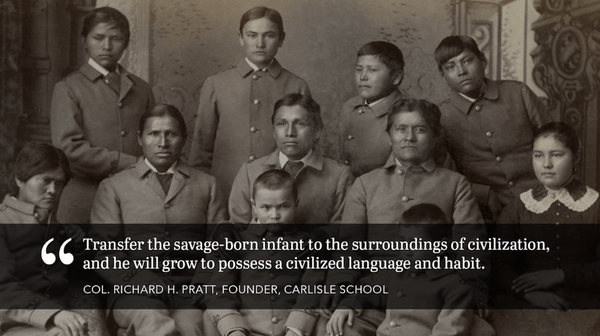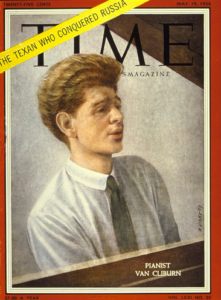Going to school for the first time is always rough. It’s every child’s annoyance and even disdain when it comes to school. Carlisle seemed like any ordinary school. It had classrooms, teachers, libraries, things that any school would have. Only this school had a unique purpose. This school was not for everyone; in fact, it was only for one group of people: Native American children. The purpose of this school was to strip these Native American children of every native tradition and custom they ever had. Their traditional clothing made of soft leather and Mulberry and redwood bark were replaced with uniforms.1 These childrens’ names were officially changed to Christian names, and they were forbidden to speak their native languages while on school premises; all teaching instruction was in English.2 Additionally, both boys and girls had to have their hair cut to an appropriate length, which was based on Anglo-Saxon cultural norms. After the students had their hair cut and their Native garb removed, they would have to choose a Christian denomination.3 The one connection the students had to their culture was one ritual dance that was performed by the students for the comic entertainment for visitors. Any other traditional dances or rituals were prohibited.4 How did this school come about?

After multiple failures of the United States government to suppress Native Americans though the use of brutal military campaigns, Thaddeus Pound, a third-term US congressman, promoted the idea of assimilation. In 1881, he proposed that it would be cheaper and easier to assimilate Native Americans rather than to continue fighting them. Stressing the civilizing of Native peoples, Pound pressured Congress that this had to be done for humanitarian purposes. The real purpose, however, was to sever the children culturally and psychologically from their culture, thus saving the Indian but at the same time destroying them by destroying their culture.5 Through this debate came the notion of educating Native children into white culture and erasing their culture through the use of forced assimilation.
The Carlisle Indian Industrial School opened in 1879 in Carlisle, Pennsylvania, by Lieutenant Richard Henry Pratt with 136 Native American Children.6 However, at the turn of the decade, the federal government acknowledged assimilation practices as Indian Policy. Carlisle then became approved as a role model for other off-reservation schools, which led to the creation of twenty-three other similar schools.7 By 1902, the number of such schools had jumped to ninety-two schools managed by the Federal government nation-wide.8 The Carlisle Indian Industrial School focused mostly on teaching low level skills to children, training them for jobs as servants and manual laborers. Education at Carlisle only lasted three years with a focus on basic English, math, writing, and labor skills.

Over time, classes grew to include students who graduated from the eighth grade and higher levels of education. After graduating, most students returned to the reservation to do small jobs such as shoe making, printing, or tailoring. Unfortunately, most of these trades proved useless on the reservations.9 Carlisle, along with other off-reservation schools across the US, held large celebrations and parades dedicated to showing the transition of students from Natives to Anglo-Saxon Americans through the use of parades, floats, and the occasional play. Most of these carried offensive and racist messages, such as “Anglo-Saxons rule the world, we submit” and “wise statesmanship demands a homogeneous population,” which were used to promote and prove the power of assimilation over Native-American populations. This led to the belief that Native culture was just a dream and not something that will grow into the Anglo-Saxon culture.10

Carlisle also sponsored extracurricular activities, which included a music program, a student-run newspaper, and a library. Most of these programs were unintended by the federal government and were created mostly by donors, teachers, and the students themselves. For instance, the library was created through the efforts of O.H. Bakeless and Pratt, who wanted Native children to have access to encyclopedias, medieval stories, and Greek and Roman history. Along with that, they added classics such as Little Women, Black Beauty and religious texts. Teachers and sponsors also played a key roles in growing the school and encouraging pupils to grow outside of the low level jobs the federal government intended for them, by providing additional funds and resources.11
The Carlisle experience had lasting repercussions for these children. Some children were able to leave reservations and find substantial employment, but unfortunately, the overall effects leaned towards the negative rather than the positive spectrum. Children experienced cultural isolation, which led to homesickness, and in extreme cases, to alienation and depression when they returned to reservations. Families that were reluctant to send their children to federal schools faced threats from the government that included removing federal funding and welfare from the family. Hence, even if the child or the family didn’t want to attend Carlisle or other schools, they had no choice. 12 Gertrude Bonnin, also known as Zitkala-sa, was a former student from Carlisle and went on to become a teacher at the school. She, like many students, had been scouted out by missionaries prior to attending Carlisle Indian Industrial School. In her case, she was recruited by the Manual Labor Institute, a Quaker mission school in Indiana. She was recruited at the age of eight, and she recalled the traumatic experiences she and others faced when going through the assimilation process. In her essay, School Days, she recalls how she hid from teachers when they told her they were going to cut her long, traditional braids. They ended up dragging her out from under a bed, tying her to a chair, and then cutting her braids with a pair of scissors. She describes this moment as the moment she lost her spirit. After Carlisle, she found herself alienated from her traditional mother and struggled to reconnect with her family for the rest of her life. She became a teacher at Carlisle for two years before going on to found the National Council of American Indians in 1926, where she served until her death in 1938. She was a prominent Native-American rights activist.13

After years of forced assimilation, the connection between the Native Americans and the Federal government became extremely fragile. With that, Native Americans decided to create laws that only effected Native Americans. The federal government agreed to this in order to reconcile with the Native peoples and let these special laws pass. The major laws were aimed towards Native-American children with the most famous one being the creation of ICWA or the Indian Child Welfare Act.14
Out of the 10,000 that went into Carlisle, 186 children from nearly fifty different tribes died, most dying of illnesses such as tuberculosis, influenza, and trachoma, an infectious eye disease. Tuberculosis, however, was the deadliest of the three. Families of the deceased children could not claim the bodies of the children, so the children’s bodies were never returned to the tribe. The children instead were given Christian burials and were buried in the Carlisle cemetery. It wasn’t until the year 2000 that the children were given proper Native burial rites, but unfortunately, the correct identification of each body had been lost due to time, loss of accurate documentation, and several relocation projects on the Carlisle Cemetery. The school is now an active military base with the cemetery located right behind the army barracks known as the Carlisle Barracks.15
- Fashion, Costume, and Culture: Clothing, Headwear, Body Decoration, and Foot wear through the Ages, 2013, s.v. “Clothing of Native American Cultures,” by Sara Pendergast, Tom Pendergast, Drew D. Johnson, and Julie L. Carnagie. ↵
- Encyclopedia of Genocide and Crimes against Humanity, 2005, s.v. “Native Americans,” by Stacie E. Martin. ↵
- Mary A. Stout, Native American Boarding Schools (Santa Barbara: ABC-CLIO LLC, 2012), 32, 34, 36. ↵
- American Eras: Primary Sources, 2013, s.v. “The Indian School at Carlisle Barracks,” by Rebecca Parks. ↵
- Scott Laderman, “‘It is cheaper and better to teach a young Indian Than to Fight an Old One’: Thaddeus Pound and the Logic of Assimilation,” American Indian Culture And Research Journal 26, no.3 (2002): 9-10. ↵
- Encyclopedia of Race and Racism, 2013, s.v. “American Indian Boarding Schools,” by Jon Reyhner. ↵
- Mary A. Stout, Native American Boarding Schools (Santa Barbara: ABC-CLIO LLC, 2012), 42. ↵
- American Eras: Primary Sources, 2013, s.v. “The Indian School at Carlisle Barracks,” by Rebecca Parks. ↵
- Mary A. Stout, Native American Boarding Schools (Santa Barbara: ABC-CLIO LLC, 2012), 38, 42. ↵
- John R. Gram, “Acting out Assimilation: playing Indian and becoming American in the federal Indian boarding schools,” The American Indian Quarterly 40, no. 3 (2016): 1-5. ↵
- Bernadette A. Lear, “Libraries and Reading Culture at the Carlisle Indian Industrial School,” Book History 18, (2015): 168, 173. ↵
- Encyclopedia of Race and Racism, 2013, s.v. “American Indian Boarding Schools,” by Jon Reyhner. ↵
- Mary A. Stout, Native American Boarding Schools (Santa Barbara: ABC-CLIO LLC, 2012), 36-37. ↵
- Timothy Sandefur, “Suffer the Little Children: US laws treats Native American Children very different from Other Children,” Regulation 40, no. 4 (2017): 1-3, 5. ↵
- Jacqueline Fear-Segal, “Institutional Death and Ceremonial Healing far from Home: The Carlisle Indian School Cemetery” Museum Anthropology 33, no. 2 (September 2010): 157-159, 164-165. ↵



53 comments
Alexa Casares
Your article honestly blew me away. It is powerful. It is crazy to see the thing people will go in order to make someone feel inferior and it shines light on what Native Americans have faced. The American government likes to paint a pretty picture but nothing here is pretty.
Gianna Salinas
This article is effective in highlighting the discrimination Native Americans have faced from the U.S. government and how it is still relevant today. I appreciate the information you offer in this article. This article did a good job showing that it took them too long to receive proper native burial. Great job and thank you for the information.
Olivia Tijerina
Before reading the articles I had an idea what assimilation was, but after reading the article, the massage led me to have more of a perspective rather then just an understanding. The article was able to bring more light into what exactly did the Native Americans face. Moreover, I understood that Native American were required to go to school but I didn’t know that the education system was only subject them to become nothing else other then to become the labor to the society. Moreover, with the image of what schooling meant to the Native Americans as well of what it meant to the others that would enforce were two different narrations.
Felicia Stewart
This article was a very interesting read. I was not familiar with this particular story before reading the article and it is tragic the discrimination many Native Americans had to face. Everything this culture knew was being taken away from them and people attempted to keep their culture from them. Everything that Native Americans knew, and that represented them and their culture, they were stripped of at the school, and in nearly any public place. I think it is devastating that they had to endure this.
Christopher Hohman
Nice article. It is terrible that some people felt that they had the right to wipe away an entire culture because it was not their own. This school sounds like it was a truly terrible place to learn. They wanted to strip Native American children of their identity and replace that with Anglo Saxon cultural norms. I am glad that today this policy is no longer practiced, but many of Native Americans still suffer debilitating poverty on reservations. There is still lots of work to do.
Sharriah Martinez
I had never heard about this tragic story. Although it did bring awareness to the historical prejudice that Native Americans have faced from colonizers. The part that broke my heart was the treatment that they endured. They were forced to assimilate into the norms colonizers had placed. This article did a good job showing that it took them too long to receive proper native burial. That is the most heart wrenching part. They were not properly laid to rest. This was a defiant dark time for our history.
Samire Adam
Although I am always hearing about the discrimination of Native Americans in American history, it somehow becomes harder and more difficult to hear about. It crazy to think about how cruel our country was towards the people that were here first. This article provided its purpose and also introduced me to a new event that happened in the United States.
Gabriela Murillo Diaz
I had heard about the Carlisle Indian Industrial School before and its importance. The story is tragic and brings awareness to the historical prejudice that Native Americans have faced from colonizers. The story is heartbreaking because of the treatment that they endured. They were forced to assimilate into the norms colonizers had placed. It took them too long to receive proper native burial. The story is heartbreaking and shines a dark light on our history. I am glad you chose this topic for your article because these are tragedies we all need to be educated on.
Irene Astran
I am working on a very similar article to this one. I appreciate the information you offer in this article. How I intend to move mine in a little different direction is by using more testimony from former students to show just how atrocious the administration of these Native American boarding schools was. It is appalling all they did to strip them of their humanity.
Lyzette Flores
It is a shame to force children to do certain things at such a young age. It is our right to provide them with guidance, teach them, and help them through life but what Carlisle did to them was not fair. They were taken the right to learn about their culture and their roots. It must have been something very traumatizing. I believe nobody, in general, deserves to go through those things.